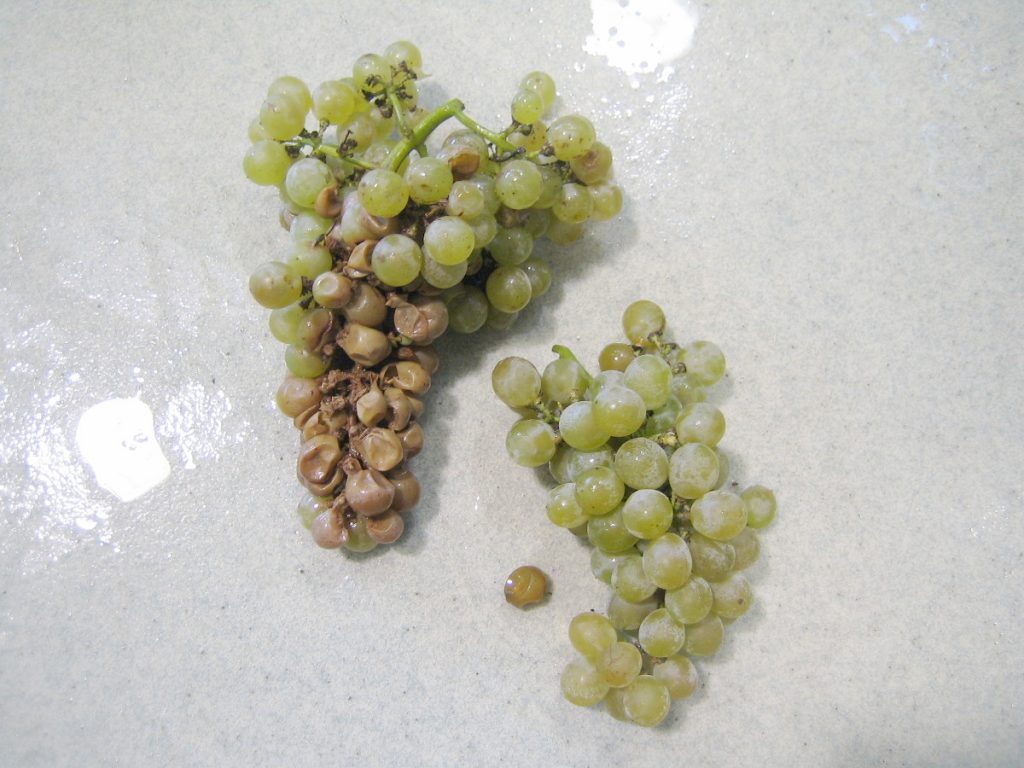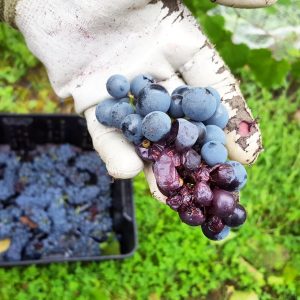
It may take one moment – one large rainstorm, a hurricane, a few hours of gusty wind – to complete turn a crop from hopeful to despair. Let’s review a few tactics that have high impact value in saving the wine’s quality from lower quality fruit.
For All Ferments: Harvest Actions
For any variety, red or white, there are a few actions wineries can take to maintain some level of wine quality by improving the fruit they start with.

Photo by: Denise M. Gardner
- Remove heavily diseased fruit pre-harvest. A day or two before harvest, it may be possible to crop thin some of the hanging fruit that is heavily diseased. This will allow pickers to focus on the fruit that is of superior quality the day of harvest.
- Sorting at the crush pad. No one likes to sort. It’s time intensive, labor intensive, and requires some extra pieces of equipment set up for harvest. But it’s also one of the best things a winemaker can do to reduce the influence of diseased or poor quality fruit. Sorting minimizes the amount of disease or rot that is brought into the cellar, reducing the impact on the wine getting made, as well as minimizing the potential for harboring contamination sites in the cellar.
- Sanitation. Cleaning and sanitation is also loathed by many wine industry members. I have heard so many winemakers tell me sanitizing their crush equipment doesn’t matter because all of the juice is getting inoculated. This statement fails to acknowledge how microorganism populations proliferate and thrive, and also fails to recognize the impact of off-flavor development or carryover. Clean your equipment. Sanitize it well. Learn how to do this properly to avoid cross contaminating future batches of wine.
Once you secure the best fruit/must/juice possible, the next two points should come naturally to any winemaker that deals with extreme vintage variation.
- Yeast Selection – Pick something reliable. “Yeast is yeast.” The purpose of the yeast strain is to get through fermentation efficiently and completely. There are two schools of thought regarding yeast selection if there was a lot of disease from the fruit. The first is using a workhorse, reliable, higher-temperature fermenting yeast strain. The benefit of these strains is that they will reliably get through the fermentation despite the disease, and the higher temperatures may help blow off some of the off-flavors associated with the rot. The second school of thought is to use a gentle yeast strain with a slower fermentation speed. This strategy is usually more common with whites and rosés, but does have some applicability for some red wine grape varieties. Here, the fermentation progresses slowly, with good temperature control, but can help generate a more complex aroma and flavor profile. The hope is this complexity out-competes any off-flavors sensorially.
- Nutrient Supplementation – There really isn’t any way around the fact that nutrient supplementation and tailoring it to the needs of the ferment is vital for good quality winemaking. Yes, I’m fully aware a lot of winemakers are going to read this and think, “I don’t bother,” or “It doesn’t matter.” Others may skip this section completely wanting to remain unbothered in measuring YAN and altering nitrogen supplementation strategies. But the reality is: in order to get good aroma and flavor, the ferments need an appropriate supply of nitrogen. That means not too much nitrogen and not too little, but juuuuuuust the right amount. Like Goldi Locks and the Three Bears: find the strategy that is just right.
For Whites: Juice Fining
Avoid taking the juice phase in white wine processing for granted. It actually provides an opportunity for improvement in several ways from how quickly a juice is settled to what fining agents can be used before or during fermentation.
In disease-heavy years, for example, the use of fermentation-bentonite may be beneficial for reducing the need to protein stabilize the wine later on in production. This can be useful for retaining wine quality if it is already in a fragile state from a poor growing season.
Additionally, there is some evidence to show bentonite additions during fermentation can help reduce laccase, the browning enzyme that develops with Botrytis infection. Laccase is not inhibited by alcohol formation or heat generated during fermentation. Thus, the use of bentonite could be helpful to minimize premature browning in young white wines that had a noticeable Botrytis issues.
But other fining may also be helpful in the juice phase, during fermentation, or at the immediate close of fermentation. Always remember to double check applications of a fining agent with the supplier. Not all fining agents produced by every supplier will have a juice application (meaning they can get added to the juice) as generally described within this post.
*Author’s Note* These points listed below are generalizations so it is always best practice to double check the specific use of a fining agent with the company that you purchase it from. Some options include:
- PVPP – Again, there is some evidence to show this can help reduce laccase and laccase byproducts for Botrytis-heavy juice or recently-fermented wine.
- β-Glucanase Enzyme – β-glucanase is an enzyme that breaks down glucans, another byproduct from Botrytis-heavy fruit. Glucans become an issue during filtration. Winemakers typically discover glucan problems right when they are ready to bottle. Today, some β-glucanase enzymes can get applied to juice or wine, which helps minimize the retention of long-structured glucans through the entire winemaking process.
- Chitosan – Chitosan and its use is becoming more popular for many different winemaking strategies. Some chitosans can add antimicrobial protection to minimize further spoilage or degradation of disease-heavy wine very early on in the winemaking process. Again, always check the application of the fining agent with the supplier.
- Lysozyme Enzyme – For fruit heavy in Gram-positive bacteria (i.e., Lactobacillus, Pediococcus, and Oenococcus), the use of Lysozyme can be beneficial to reduce population numbers. Again, use according to supplier directions. (How would one know if a juice is heavy in any of the above microorganisms? Why, by using a microscope of course!)
Red Wines: Re-Think Wine Processing
Some years are just not made for all red wines. There’s no way around that point.
But if you find yourself with some immature or disease-ridden red winegrapes, here are a few considerations for salvaging the vintage:

Photo by: Denise M. Gardner
- Avoid Unnecessary Processes – (*cough, cough* Example: Cold Soaking!) Beyond my sarcastic comment here, it’s true winemakers have to look beyond what they usually do or typically think about extracting and retaining red wine color. The number one thing that influences red wine color is pH, and the number two thing that influences red wine color is phenolic extraction (having enough substrate to provide a visual color). In disease-ridden years, it’s possible both the pH and phenolic content of the fruit may be abnormal. Thus, winemakers need to stop stressing about risky steps like cold soaks, extended macerations, delaying malolactic fermentation, and even saignée. These processes do not happen in a vacuum. Sometimes, the process may be more likely to exacerbate the risks (i.e., spoilage, increase in volatile acidity, generation of off-flavors) in disease-heavy years as opposed to highlighting the positive feature of the process (i.e., improving red wine color). And while it may be unpopular to say this, there’s a reason why MegaPurple and Purple 8000 are so lucrative. Sometimes, these vintages are the reason.
- The Timing Between Primary Fermentation and MLF – I think I am generally in favor of co-inoculating red wines during disease-heavy years. Many winemakers fear this tactic, worried it will degrade red wine color or generate high volatile acidity (VA). The red wine color intensity becomes a moot point for me in disease-heavy years because it is always, always easier to add red wine color as opposed to making an appealing red wine. The high VA fear is related to research from the 1980s and 1990s that generally ousted the use of co-inoculation or co-fermentations from industry practice. However, today, most suppliers can make solid recommendations for yeast and malolactic strains that work together without causing high VA’s in the wine. The benefit is completing both fermentations quickly, which allows the winemaker to properly stabilize and store the wine more quickly.
- Pressing Off Skins Early – The skins of grapes contain color, flavor, and phenolic substrates that are often desirable for wines. However, in disease-ridden years, the skins also contain lots of the disease and off-flavors associated with the rot. Thus, minimizing contact with the must can benefit the wine by reducing the concentration or intensity of extracting those negative substrates. Again, I tend not to prioritize red wine color with these decisions because it can be more easily altered through blending or the use of a grape concentrate like MegaPurple or Purple 8000.
For me, these tougher vintages start to separate winemaker skillsets. Winemakers who aren’t able to make on-the-fly decisions with a high set of variables struggle to make quality wines during disease-ridden vintages. But it doesn’t have to be that way!
After wines are complete, there’s also places within later-stage processing operations that can be adjust to redeem the quality of the wines. These are good opportunities for a winemaker to put quality-first! Nonetheless, altering such processes requires some thought and strategy before moving the wine through its normal operations.
Some vintages will test the skills of the best of us, and wines can still turn out subpar. If that is the case, don’t forget that there are resources out there that can improve a wine post-fermentation. Now, most of us are not miracle workers. But, there are services available that may provide some alternative solutions to a wine in an effort to preserve a wine brand’s reputation. One of the easiest and most cost-effective ways to learn is through our DGW Elite Membership, which offers virtual discussions twice a month to help you make better wine. Click on the link to learn more!
The views and opinions expressed through dgwinemaking.com are intended for general informational purposes only. Denise Gardner Winemaking does not assume any responsibility or liability for those winery, cidery, or alcohol-producing operations that choose to use any of the information seen here or within dgwinemaking.com.
